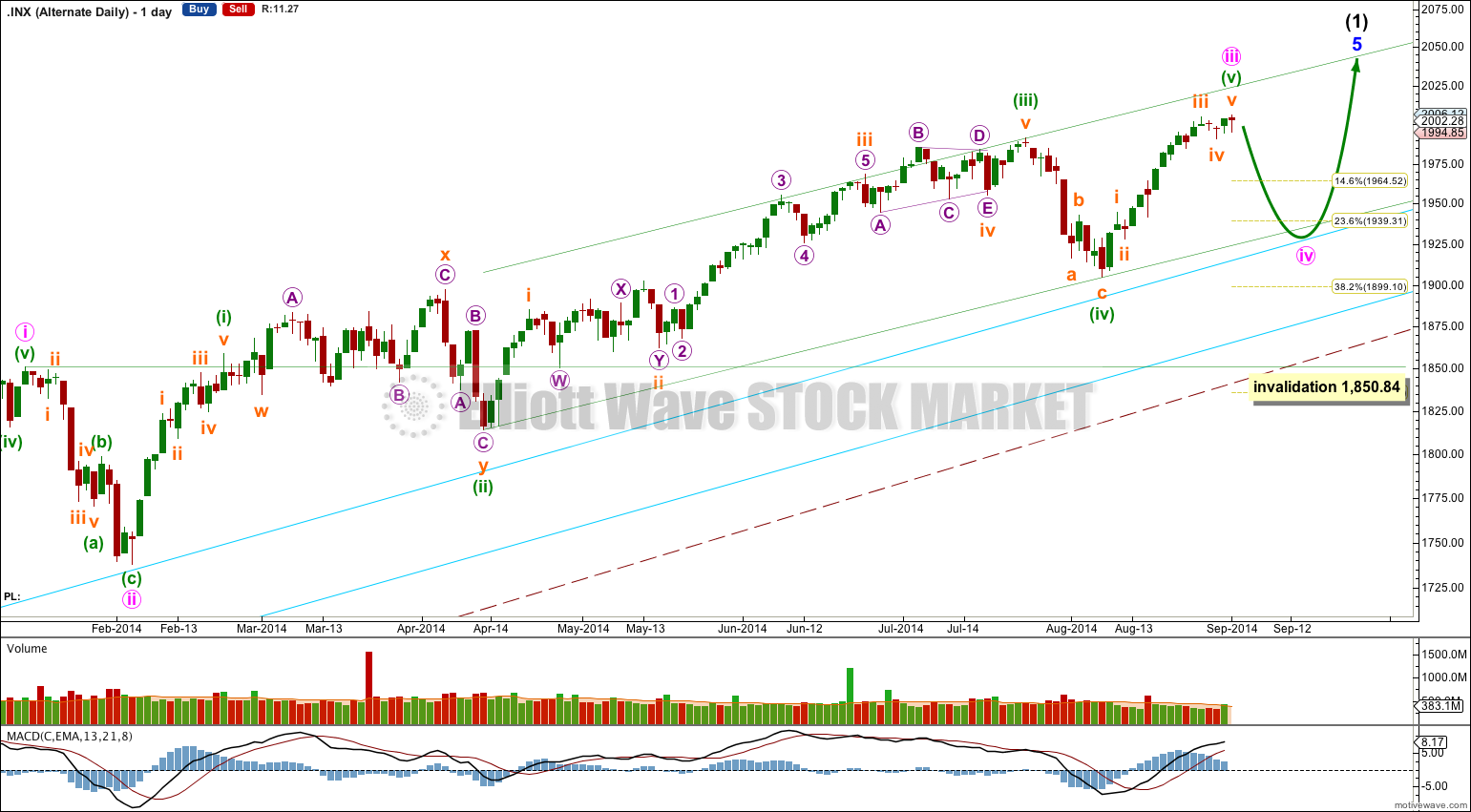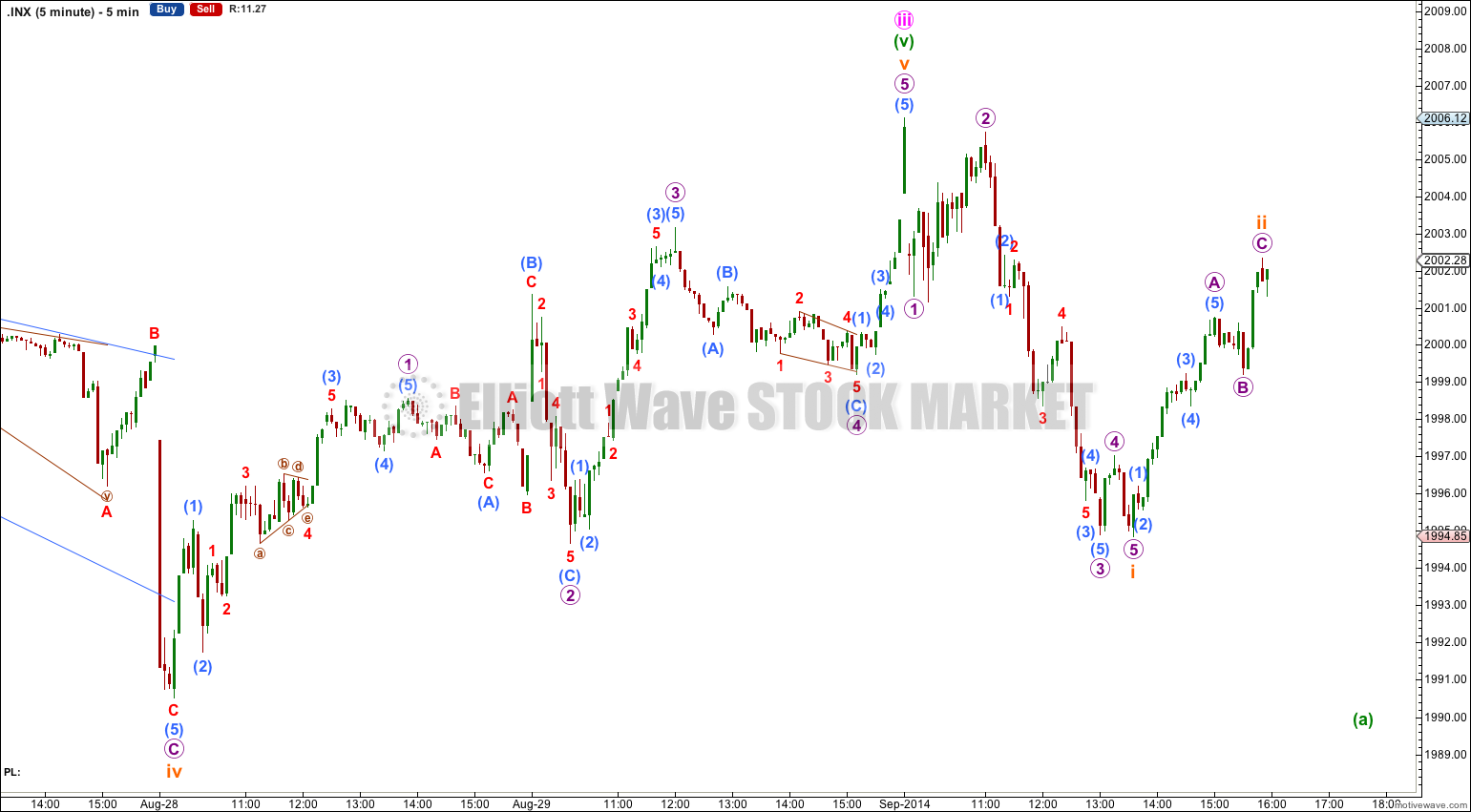Although price began the new week with very slightly higher movement, the target has not been met and Tuesday’s small red candlestick indicates the target may not be met. I have two Elliott wave counts for you. The confirmation / invalidation points are very close together and tomorrow should clarify the situation.
Summary: A new high above 2,006.12 would indicate upwards movement should continue towards the target zone of 2,025 – 2,031, favouring the upper edge of that zone. A new low below 1,990.52 tomorrow would indicate the next reasonably sized fourth wave correction may have arrived.
Click on charts to enlarge.
The aqua blue trend lines are critical. Draw the first trend line from the low of 1,158.66 on 25th November, 2011, to the next swing low at 1,266.74 on 4th June, 2012. Create a parallel copy and place it on the low at 1,560.33 on 24th June, 2013. While price remains above the lower of these two aqua blue trend lines we must assume the trend remains upwards. This is the main reason for the bullish wave count being my main wave count.
Bullish Wave Count.
There are a couple of things about this wave count of which I am confident. I see minor wave 3 within intermediate wave (1) as over at 1,729.86 (19th September, 2013). It has the strongest upwards momentum and is just 0.76 longer than 2.618 the length of minor wave 1. At 455 days duration this is a remarkably close Fibonacci ratio. The subdivisions within it are perfect. If this is correct then minor wave 4 ends at 1,646.47 and this is where minor wave 5 begins.
Because there is already a very close Fibonacci ratio between minor waves 1 and 3 I would not actually expect to see a Fibonacci ratio between minor wave 5 to either of 1 or 3. This means that the target for intermediate wave (1) to end would best be calculated at minute wave degree, within minor wave 5. I will not be able to do that until minute wave iv has ended.
Minor wave 5 is unfolding as an impulse. If minor wave 5 has passed its middle then I would expect to see more divergence between price and MACD develop over coming weeks.
Along the way up towards the completion of intermediate wave (1) I would expect one more correction complete for minute wave iv, which should not breach the upper of the two aqua blue trend lines given that the upper trend line has held for over a year now.
Within minuette wave (v) no second wave correction may move beyond the start of its first wave below 1,904.78.
Within minute wave iii there is no adequate Fibonacci ratio between minuette waves (iii) and (i). This makes it more likely that minuette wave (v) would exhibit a Fibonacci ratio to either of minuette waves (i) or (iii). At 2,025 minuette wave (v) would reach equality in length with minuette wave (i). As this is the most common relationship between first and fifth waves this should be the first expectation.
If price keeps rising through this target then I will again calculate a second higher target, although at this stage looking at trend channels and time frames this first lower target looks much more likely to be correct so I will leave it as the sole target for now.
Minuette wave (v) has now lasted 17 sessions. If it completes in a total Fibonacci 21 sessions it may end in four more sessions. This expectation of a Fibonacci duration for minuette wave (v) is a rough guideline only. Minuette wave (i) lasted 12 sessions, just one short of a Fibonacci 13, and minuette wave (ii) lasted a Fibonacci 34 sessions. Minuette wave (iii) lasted 71 sessions has no Fibonacci duration nor ratio in time to minuette waves (i) or (ii). This illustrates that sometimes the S&P exhibits Fibonacci durations and ratios between waves for time taken, but not always. It cannot be relied upon.
I have redrawn the parallel channel about minute wave iii using Elliott’s second technique: draw the first trend line from the lows of minuette waves (ii) to (iv), then place a parallel copy on the high of minuette wave (iii). Minuette wave (v) may end about the upper edge of this channel.
The large maroon – – – channel is copied over from the weekly chart. It is drawn in exactly the same way on bull and bear wave counts. For the bull wave count this channel is termed a base channel about primary waves 1 and 2. A lower degree second wave should not breach the lower edge of a base channel drawn about a first and second wave one or more degrees higher. The lower maroon – – – trend line differentiates the bull and bear wave counts at cycle degree and monthly chart level.
Main Hourly Wave Count.
This wave count expects the short term trend to remain the same, upwards, until proved otherwise. Within subminuette wave v now only micro wave 1 may be over. Micro wave 2 may not move beyond the start of micro wave 1 below 1,990.52.
Price is below the channel drawn using Elliott’s second technique. This indicates a trend change, but I will leave this wave count as a main wave count until the trend change is confirmed by price action with a new low below 1,990.52. Sometimes fifth waves for the S&P 500 are particularly weak and do not always nicely conform to channels.
This main wave count expects a four more days of upwards movement towards the target, with an increase in upwards momentum tomorrow for a small third wave.
Alternate Bullish Wave Count.
Minute wave iii could be over sooner than expected, falling short of the target. Minute wave iv may have begun on Tuesday.
Minute wave ii lasted 14 sessions, and was a relatively deep 55% zigzag. Minute wave iv should last a bit longer and is most likely to be a flat, combination or triangle (they’re normally more time consuming structures than zigzags). It should be very choppy and overlapping, generally trending downwards, and may reach only the 0.236 Fibonacci ratio of minute wave iii at 1,939.31 (or above). I would expect it to end before it touches the upper aqua blue trend line on the daily chart.
There may be a new price extreme above its start at 2,006.12 within minute wave iv, if it is a very common expanded flat or a running triangle or a combination, but a small five down on the hourly chart needs to happen first.
The breach of the channel about minuette wave (v) may be the first indication of this trend change. This change needs confirmation with a new low below 1,990.52.
In the very first instance a first five down needs to unfold, and within that no second wave correction may move beyond the start of its first wave above 2,006.12.
Bearish Alternate Wave Count
This bearish alternate wave count expects that the correction is not over. The flat correction which ended at 666.79 was only cycle wave a (or w) of a larger super cycle second wave correction.
The structure and subdivisions within primary wave C for the bear wave count are the same as for intermediate wave (1) for the bull wave count. Thus the short to mid term outlook is identical.
The differentiation between the bull and bear wave count is the maroon – – – channel. The bull wave count should see price remain above the lower maroon – – – trend line. The bear wave count requires a clear breach of this trend line. If this trend line is breached by a full weekly candlestick below it and not touching it then this bear wave count would be my main wave count and I would then calculate downwards targets.
We should always assume the trend remains the same until proven otherwise; the trend is your friend. While price remains above the lower maroon – – – trend line I will assume that the S&P 500 remains within a bull market.
This analysis is published about 07:48 p.m. EST.






